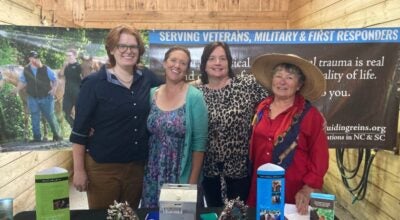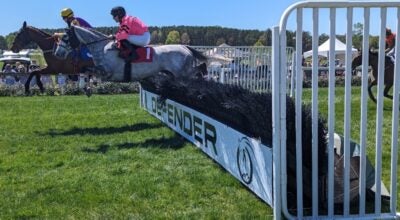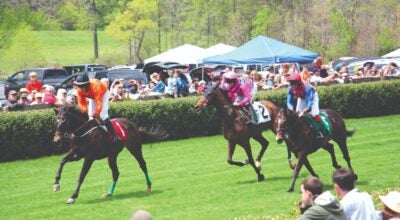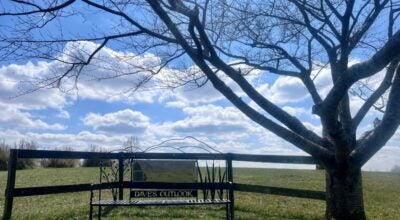The Huntsmen and the Hounds
Published 1:41 pm Monday, October 3, 2016
Written By Judy Heinrich
Photos submitted
Horse people are almost always dog people, too, even as we readily admit that both species add a lot of work as well as joy to our lives.
But just imagine keeping your one or two or a few horses while raising your canine quota to somewhere north of 50. That’s more than 50 active dogs of assorted ages that you are responsible for breeding, feeding, care giving, training and exercising… LOTS of exercising. And, oh yeah, in addition to your own property you’ll be responsible for monitoring thousands of acres of fields and trails on land that you don’t own, doing what’s necessary to keep them in good shape so you can lead enthusiastic parties of riders across them a couple of times a week for many months each year.
Those are only parts of the job assumed by Huntsmen, the backbone of foxhunts in our country and around the world. Polk County is lucky to have two longtime foxhunts, Tryon Hounds and Green Creek Hounds, which are 90 and 27 years old, respectively. We’re pleased to highlight the Huntsmen of both, the people who do so much to ensure that foxhunting will be part of the Foothills tradition for decades to come.
Tot Goodwin
Green Creek Hounds
Jefferson “Tot” Goodwin grew up on a farm in Columbus, Ga., where his family worked the land with mules and raised cotton and corn. Horses were not a part of his childhood but hunting and hounds definitely were. “Everyone hunted with packs of hounds for coons and rabbits,” he says. “I’ve been hunting since I could walk, and had my own pack of beagles when I was 8 years old.”
One day Tot was following a hunt on foot that was being led by Ben Hardaway, the legendary Master of Georgia’s Midland Hounds. “Mr. Hardaway was walking across a big cornfield but I could see that some of his hounds were about to follow the fox across a highway. I was able to stop them and probably kept them from being killed.”
Mr. Hardaway asked Tot’s older brother, who worked at his Ford dealership, if Tot might want to come work with his hounds and horses. Tot started in September 1964 and the following year Hardaway’s trainer taught him to ride. He was soon helping break and train young hunt horses and eventually became an expert Whipper-in, responsible for helping the Huntsman by keeping the pack together on the hunts. “I took to it right away,” Tot recalls. “It’s like I was born to do it.”
During 20 years with the Midland Hounds, Tot rode with hunts across the U.S. and even in England and Ireland, where he was the first black man to ever foxhunt.
Tot had transitioned into the logging business when he got a call from Polk County horsewoman Peg Secor, who wanted to start a new foxhunt. She knew Tot’s reputation and asked if he would come teach her how to get started. He came in 1989 for what he thought would be four weeks and has been here ever since. He was named Green Creek Hounds Huntsman in 1990, the same year the hunt was recognized by the Master of Foxhounds Association. In 1997, Secor named him a Master of the hunt, an unusual honor for a Huntsman. Tot still serves as both Huntsman and Joint Master today, with fellow Joint Masters Kem Ketcham, Deborah Bundy and Christi Fowler.
The Huntsman’s Job
A Huntsman is not only responsible for training the hounds and controlling them in the field on hunt days, he or she provides all of their care and conditioning throughout the year, and is also responsible for monitoring and maintaining the land in the foxhunt’s territory.
On a hunting day Tot gets his start at 4 a.m., and on a non-hunting day he tries to walk out the door at 8 a.m. to start feeding, cleaning and checking out the hounds. GCH now has 65 hounds (or “32 couples plus one”), a cross of English, American and July hounds. Tot takes them out everyday for an hour of exercise. “You have to stay close to your hounds and spend every minute you can with them,” he says. “There’s just a knack to making hounds like you – everybody ain’t got it, no matter how hard they try.”
Once the hounds are taken care of, a typical non-hunt day will have fields to be mowed, jumps to be repaired, trees to get off the trails, and something somewhere that needs fixing. “Plus you have to spend an hour at Cocula,” Tot laughs about his favorite local lunch spot.
GCH has several seasons each year. In the spring, “cubbing” rides combine young hounds and young horses with riders new to the sport so all of them can learn in a less stressful atmosphere.
GCH has an early season from mid-July up to the November opening of the traditional hunt season, which lasts through February with hunts every Thursday and Sunday, weather permitting. There are also numerous social events throughout the year, from hunt breakfasts and dinners to an annual ball and other gatherings, with Tot an important part of all.
“Being a Huntsman isn’t really a job, it’s a lifestyle,” Tot says. He’s also been known to only-half-kiddingly refer to the challenge of keeping hounds, horses, hunters, and landowners safe and happy as “a nightmare, a real nightmare to keep it all going!” But it’s a nightmare he relishes: “It gives you a good feeling that you can accomplish that. You have to be very good to accomplish all of it together. And I assure you it didn’t come overnight either, it’s years of knowing how to deal with all that stuff.”
Helping Tot “deal with all that stuff” is the kennel helper he met on his first day with Peg Secor, a young Canadian transplant named Colleen Wilson. After 19 years of working together as Huntsman and Kennelman, Tot and Colleen were married on March 27, 2008. In addition to the hunts, the couple shows GCH hounds on the April-May Hound Show circuit most years, and have won numerous championships and other high placings. In 2015, Green Creek Bankrupt was the Grand Champion of the Carolinas Hound Show and they won the Crossbred Pack Class Championship at the prestigious Virginia Hound Show, two accomplishments they’re especially proud of.
Green Creek’s Territory
GCH hunts on a territory that runs from the Shiloh area of western Rutherford County all the way to the Chesnee Highway. Those thousands of acres encompass five or six different “fixtures” or hunt meet sites, on land that is mostly owned by Roger Smith.
Roger, himself a former GCH Master, has known Tot for years. “He is a hunting genius, the way he controls and leads his hounds,” he says of Tot. “And he can outride anybody in the field. Try to keep up with him and you’ll understand what I mean. On top of that, he’s a hard worker and a very nice man. I’m glad our paths crossed.”
Now 72, Tot says he plans to stay on as Huntsman as long as he’s able. He and Colleen are both tough enough to keep going. “In 27 years of hunting I’ve only seen him fall off three times,” she says. He’s seen her fall on occasion himself. Fortunately they both share the same philosophy when that happens: they slow down enough to shout, “You okay?” and if they get a nod, they take back off running.
Beth Blackwell
Tryon Hounds
In August, Tryon Hounds announced the appointment of Beth Blackwell as its new Huntsman. While Beth is new to Tryon, she’s not new to the sport, the South, or the Carolinas.
Beth was born in Ozark, Ala., and spent her early childhood there before moving to Charleston, where her father was a professor at the College of Charleston. She began riding at 9 years old and was lucky enough to ride with the college kids at Middleton Place Equestrian Center, adjacent to the National Historic Landmark Middleton Place plantation (circa 1600s).
Beth competed in Hunter/Jumpers for many years and started giving lessons and training horses at the age of 16. Her career as a professional rider and trainer took her to many different parts of the country.
“At one point I had a little pony barn in northwest Florida and was looking for a show circuit for the kids I was teaching,” she remembers. “Someone suggested the Auburn University Show Circuit, so I started taking them up there.” It was not only a good suggestion for the riders, it would ultimately set Beth’s equestrian life on a totally new course.
It was through the Auburn Show Circuit that she met Herb Schneider, who ran the hunt seat program for Auburn University’s Intercollegiate Horse Show Team. He was also Master of the Cedar Way Bassets, a foot hunting pack for rabbit and small game. He introduced Beth to hunting, first on foot hunts with the bassets and then by inviting her to go on a mounted foxhunt in rural Alabama in 1999. She’s been hunting on foot and horseback ever since.
Beth has hunted in 11 states, has served as both honorary and professional Whipper-in for five packs, and hunted foxhounds professionally at Tennessee Valley Foxhounds in the Knoxville area and De La Brooke Foxhounds in Maryland.
Here Come the Bassets!
When Herb Schneider died in 2004, Beth inherited the Cedar Way Bassets and a horn. She has continued breeding, hunting, and caring for the pack, which has now relocated with her to the Tryon Hounds kennel. Hunting Bassets are not the typical heavy English or American types most commonly seen as family pets. Beth’s pack is bred as ¾ French Bassets and ¼ Petit Basset Griffon Vendeen, or PBGV. Their coats can be smooth, coarse, or somewhere in between.
Beth will be working with the Tryon Hounds board to formalize a foot hunt program for members. “We’re really excited about the basset hunts,” said Rebecca “Becky” Barnes, president of the Tryon Hounds board of directors. “It’s fun to be adding something completely new in our 90th year. The basset hunts are something we can do when our mounted hunts get weathered out. And our social members, who don’t do the mounted hunts, are really excited about this new opportunity.”
Choosing Tryon Hounds
About accepting the Tryon Hounds position Beth says, “The fact that it was Tryon was the only reason I was willing to move. There’s a wonderful network of people in the hunt world who are dedicated to helping you get into the spot that will fit you. That’s important because changes in Huntsmen and staff can be extremely traumatic on a pack of hounds, so you want to be sure it’s a good fit. I kept getting calls saying, ‘Tryon is the place you need to go.’”
Becky Barnes says Tryon Hounds board members were getting calls themselves. “We had many people calling us to say, ‘Beth is the person you need to get.’ We actually looked at seven or eight candidates but wanted Beth because of her experience and the fact that she’s used to hunting land similar to ours.
“Hunting huge tracts of undeveloped land is different than our situation where we have developments and roads all around our territory. Our hounds have to be very well trained for this kind of situation.”
Season and Territory
The Tryon Hounds begin their cubbing season in September, followed by the traditional hunt season opening on Thanksgiving Day and running through Mid-March. Prior to that Beth will be working with the pack and learning the territory with the help of longtime Joint Masters Louise Hughston, Bonnie Lingerfelt and Dean McKinney, and honorary Whips Reed McNutt and Kasey Minnick. Tryon Hounds also has a crew of “road whips” who follow the hunts by car, communicate with hunt staff, and alert traffic.
Tryon Hounds is lucky to have a large and diverse hunt territory in both North and South Carolina, according to Becky Barnes. “It extends essentially from Highway 9 westward to the Blue Wall, including Caroland, Gowensville, Green Space and Golden Hills of Fairview, and places on the Collinsville trail system.
“We added Walnut Creek Preserve last year and just added 4,000 acres of private land called Tyger Ranch down in Union County. We’re now working to open 1,000 acres in North Greenville County that back up to the Blue Wall Preserve.”
Tryon Hounds also enjoys an annual hunt at Good Hope Plantation, a private 13,000-acre hunting plantation in Beaufort County, S.C.
Taking the Reins
If assuming the Huntsman role for a hunt with that much territory, more than 200 landowners, and a total of 164 active riding and social members sounds like a challenge, it undoubtedly is. But one of the things that attracted Beth to the Tryon position is what she descries as the unique support system in the Carolinas.
“The group of Huntsmen in the Carolinas is a tight group, very different than in some other parts of the country,” she says. “Hunts here are very supportive of each other. I really like that sort of community among hunts because as Huntsman you rely on so many other Huntsmen for advice and solutions. And I’m very excited to be back in the South and in the Carolinas.”







